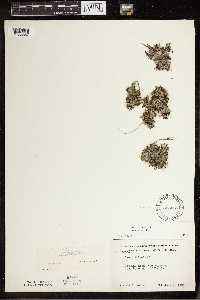Lemna trisulca
|
|
|
|
Family: Araceae
Ivy-Leaf Duckweed
[Hydrophace trisulca (L.) Bubani, moreLenticula ramosa Lam., Lenticula trisulca (L.) Scop., Staurogeton trisculus (L.) Schur] |
Roots to 2.5 cm (sometimes not developed), tip pointed; sheath not winged. Green stalks 2--20 mm. Fronds submersed (except when flowering or fruiting), 3--50, coherent and very often forming branched chains, narrowly ovate, flat, thin, 3--15 mm (excluding stalk), 2--3.5 times as long as wide, base suddenly narrowed into green stalk, margins denticulate distally; veins (1 or) 3, lateral veins only in proximal part of frond; papillae absent; anthocyanin often present; air spaces shorter than 0.3 mm; turions absent. Flowers: ovaries 1-ovulate, utricular scale with narrow opening at apex. Fruits 0.6--0.9 mm, laterally winged toward apex. Seeds with 12--18 distinct ribs, staying within fruit wall after ripening. 2n = 40, 42, 44, 60, 63, 80. Flowering (rare) late spring--summer. Mesotrophic, quiet waters rich in calcium, in cool-temperate regions; 0--3000 m; Alta., B.C., Man., N.B., N.W.T., N.S., Nunavut, Ont., P.E.I., Que., Sask., Yukon; Alaska, Ariz., Ark., Calif., Colo., Conn., Idaho, Ill., Ind., Iowa, Kans., Maine, Md., Mass., Mich., Minn., Mo., Mont., Nebr., Nev., N.H., N.J., N.Mex., N.Y., N.Dak., Ohio, Oreg., Pa., R.I., S.Dak., Tenn., Utah, Vt., Va., Wash., W.Va., Wis., Wyo.; nearly worldwide, except arctic and antarctic regions and South America; in warm regions only in mountains. The report of Lemna trisulca in Florida is dubious because the climate is too warm. The species may be temporarily introduced there by birds.
Plant: small aquatic plant Leaves: FRONDS submerged, 3-50 cohering and very often forming branched chains, narrowly ovate, 3-15 mm long (without stalk), 2-3.5 times as long as wide, flat and thin, narrowed at the base into a 2-20 mm long green stalk; margins distally denticulate; nerves (1-)3, the laterals only in the lower part of the frond; papillae absent; anthocyanin often present; air spaces smaller than 0.3 mm Flowers: rare (the flowering fronds floating on the water's surface), 1-ovulate, the small utricular scale with a narrow opening at the top Fruit: 0.6-0.9 mm long, laterally winged towards the top SEEDS: with 12 to 18 distinct ribs Misc: Mesotrophic, quiet waters rich in calcium; 2100-2700 m (7000-9000 ft); May-Aug Notes: root up to 2.5 cm long (sometimes not developed), the sheath unwinged, the tip pointed; turions absent REFERENCES: Landolt, Elias. 1992. Lemnaceae. Ariz.-Nev. Acad. Sci. 26(1)2. Aquatic herb Flowers: occurring rarely, lacking sepals and petals, with two stamens, surrounded by a membraneous scale with a narrow opening at the tip. Fruit: bladder-like (utricle), thin-walled, 0.6 - 0.9 mm long, winged laterally toward tip, seeds having twelve to eighteen distinct ribs and remaining in fruit wall after ripening. Roots: to 2.5 cm long with a pointed tip, sometimes absent. Plant body: not differentiated into stem and leaves, submersed (except when flowering and fruiting), often forming a branched mass of three to 50, connected by green stalk-like structures (stipes) 2 - 20 mm long, green, sometimes with some purple, 3 - 15 mm long, two to three and a half times as long as wide, flattened, oblong lance-shaped to elliptic or narrow egg-shaped with base suddenly narrowing into stipe and margins finely toothed near tip, three-veined, projections absent. Air spaces inside the plant body are shorter than 0.3 mm. Similar species: Lemna trisulca is easy to distinguish from other species of Lemna by having a submersed branched mass of plant bodies connected by distinctive green stalk-like structures (stipes). Flowering: late spring to summer Habitat and ecology: Frequent in quiet waters, but not as common as Lemna minor. Occurence in the Chicago region: native Etymology: Lemna is the Greek name for a water weed. Trisulca means three-furrowed. Author: The Morton Arboretum Thallus thin, oval or oblong, denticulate or erose toward the tip, obscurely 3-nerved, tapering to a 4-16 mm stipe that remains attached to the parent plant, forming tangled colonies, mostly floating just beneath the water-surface, emersed in fl and fr; spathe open; seed solitary; 2n=20, 40, 60, 80. Widespread in both the Old and New Worlds, and throughout our range. Gleason, Henry A. & Cronquist, Arthur J. 1991. Manual of vascular plants of northeastern United States and adjacent Canada. lxxv + 910 pp. ©The New York Botanical Garden. All rights reserved. Used by permission. From Flora of Indiana (1940) by Charles C. Deam Found commonly in ponds, shallow lakes, sloughs, and bogs, often growing beneath floating species, preferring cold, shaded water. …… Indiana Coefficient of Conservatism: C = 6 Wetland Indicator Status: OBL |




























































































